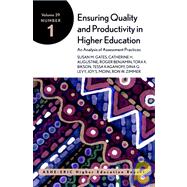Ensuring Quality and Productivity in Higher Education: An Analysis of Assessment Practices: ASHE-ERIC Higher Education Report, Volume 29, Number 1
, by Susan M. Gates; Catherine H. Augustine; Roger Benjamin; Tora K. Bikson; Tessa Kaganoff; Dina G. Levy; Joy S. Moini; Ron W. Zimmer- ISBN: 9780787958404 | 0787958409
- Cover: Paperback
- Copyright: 5/1/2002
A detailed review of the quality assurance and productivity oversight processes being applied today by agencies given the task of assessing and evaluating education and professional development activities, this book identifies what is working well, and what could be improved. Using the results of a Rand research study conducted, the authors present four successful approaches, key factors to consider and critical lessons learned about the assessment process. Using documentation of organizations engaged in assessment, interviews with experts, conferences, and site visits, the authors also examine the main task of assessment to focus on quality and productivity of specific providers and explore the overall purpose of such studies to provide a higher-level assessment of the system as a whole. They analyze these two main purposes of assessment as they impact stakeholder and system-level needs as well as provide opportunities for program-wide improvements.This book also discusses the emerging trend of corporate learning organizations, and demonstrates how such organizations are now indispensable tools in promoting communications among stakeholders and developing strong links between professional development programs and the system's basic mission.The authors analyze key similitaries and differences among the approaches studied and present four basic models of assessment and evaluation. Each model's strengths and specific applicable characteristics are classified with six crucial factors most important to consider when deciding what model might serve your system best. Three key steps in the process of assessment, regardless of the model selected or the system assessed, are detailed with the several lessons learned in the field concerning their successful application.Finally, for providers in professional development courses meeting the challenge of a lack of preexisting evaluation tools, guidelines for developing measures of learning outcomes are presented with their specific needs in mind.






